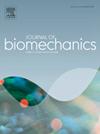Upper and lower limb muscle stiffness in children with cerebral palsy compared to typically developing children: Insights from shear wave elastography
IF 2.4
3区 医学
Q3 BIOPHYSICS
引用次数: 0
Abstract
Children with spastic cerebral palsy (CP) experience altered muscle tone due to biomechanical changes, traditionally assessed through clinical scales. Shear wave elastography (SWE) offers a non-invasive way to quantify these changes. This study aimed to compare SWE measurements in spastic CP and typically developing (TD) children and investigate influencing factors such as joint position, range of motion, demographics, physical condition and, in CP children, the characteristics of CP. It also examined correlations between SWE measurements and spasticity scales in CP children. SWE measured the elastic modulus (kPa) of biceps brachii (BB), pronator teres (PT), adductor longus (AL), lateral gastrocnemius (LG), and soleus (SOL) muscles at rest and during maximum passive stretching (MPS) in 34 spastic CP children (age: 3–17) and 44 TD children (age: 3–14). Significant differences (p < 0.05) in SWE were found between CP and TD children. CP children had lower values in upper limb muscles and higher values in lower limb muscles at rest, with the opposite pattern during MPS. The Ashworth and Tardieu scales were associated with the elastic modulus in lower limb muscles (AL, GL, and SOL) at rest in CP children. Variations in elastic modulus at rest and MPS between upper and lower limbs and in spastic CP and TD children were revealed with no consistent correlation with spasticity scales. These variations were linked to neurological dysregulation and muscle architecture, with joint structures also affecting. SWE may offer a more precise assessment of muscle spasticity, minimizing the impact of confounding joint structures.
求助全文
约1分钟内获得全文
求助全文
来源期刊

Journal of biomechanics
生物-工程:生物医学
CiteScore
5.10
自引率
4.20%
发文量
345
审稿时长
1 months
期刊介绍:
The Journal of Biomechanics publishes reports of original and substantial findings using the principles of mechanics to explore biological problems. Analytical, as well as experimental papers may be submitted, and the journal accepts original articles, surveys and perspective articles (usually by Editorial invitation only), book reviews and letters to the Editor. The criteria for acceptance of manuscripts include excellence, novelty, significance, clarity, conciseness and interest to the readership.
Papers published in the journal may cover a wide range of topics in biomechanics, including, but not limited to:
-Fundamental Topics - Biomechanics of the musculoskeletal, cardiovascular, and respiratory systems, mechanics of hard and soft tissues, biofluid mechanics, mechanics of prostheses and implant-tissue interfaces, mechanics of cells.
-Cardiovascular and Respiratory Biomechanics - Mechanics of blood-flow, air-flow, mechanics of the soft tissues, flow-tissue or flow-prosthesis interactions.
-Cell Biomechanics - Biomechanic analyses of cells, membranes and sub-cellular structures; the relationship of the mechanical environment to cell and tissue response.
-Dental Biomechanics - Design and analysis of dental tissues and prostheses, mechanics of chewing.
-Functional Tissue Engineering - The role of biomechanical factors in engineered tissue replacements and regenerative medicine.
-Injury Biomechanics - Mechanics of impact and trauma, dynamics of man-machine interaction.
-Molecular Biomechanics - Mechanical analyses of biomolecules.
-Orthopedic Biomechanics - Mechanics of fracture and fracture fixation, mechanics of implants and implant fixation, mechanics of bones and joints, wear of natural and artificial joints.
-Rehabilitation Biomechanics - Analyses of gait, mechanics of prosthetics and orthotics.
-Sports Biomechanics - Mechanical analyses of sports performance.
 求助内容:
求助内容: 应助结果提醒方式:
应助结果提醒方式:


